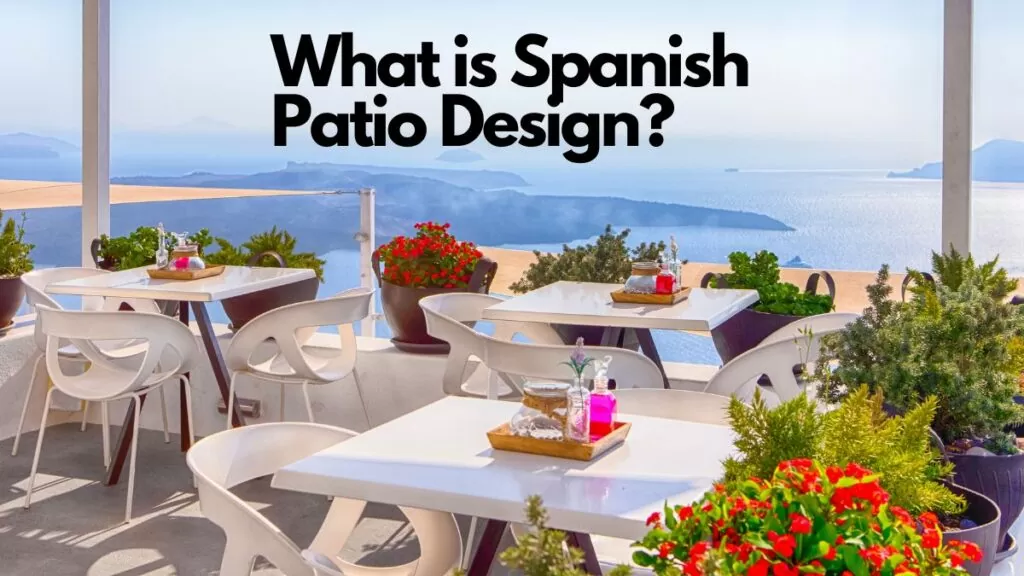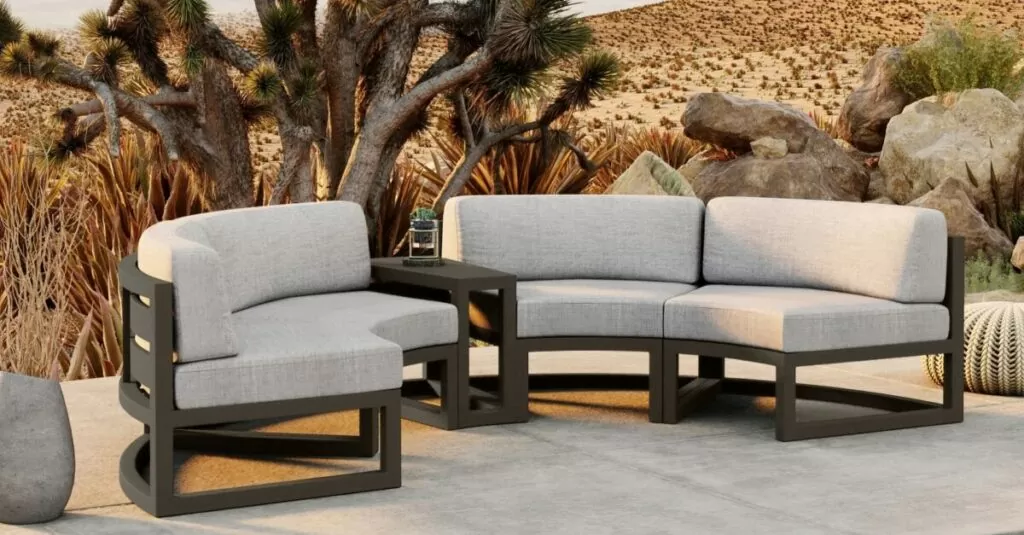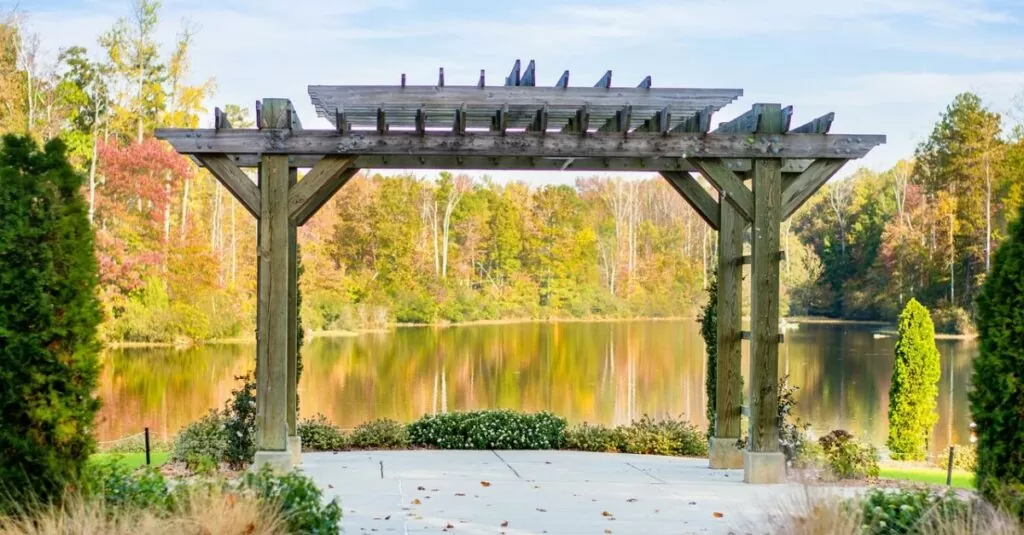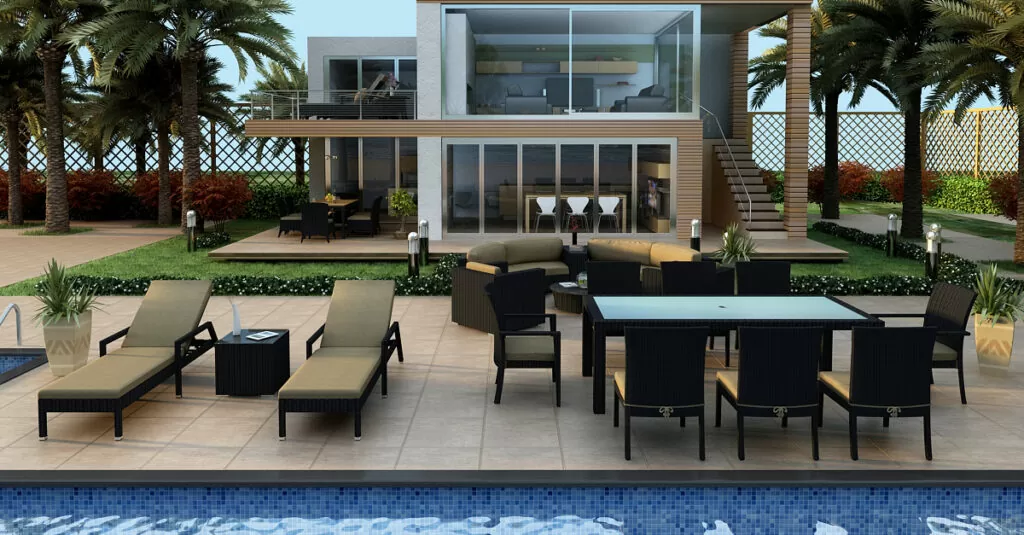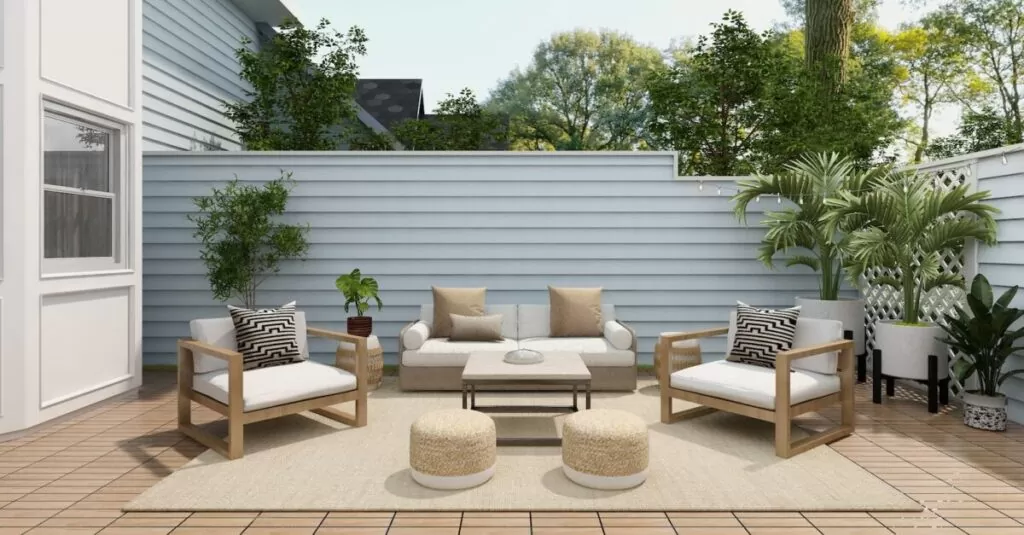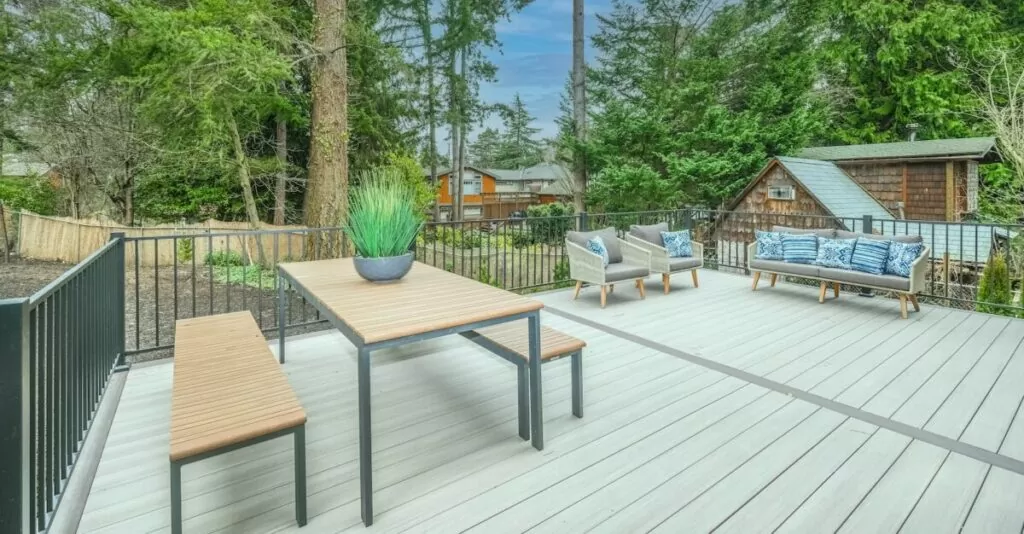You’ve probably admired those beautiful, warm, and inviting outdoor spaces in classic Spanish homes. With their distinct architectural details, lush greenery, and timeless appeal, these patios can make you feel like you’re on a permanent vacation right within your home’s confines. This is the allure of Spanish patio design – a style characterized by its rich history, unique elements, and inherent charm.
As we dive into the world of Spanish patio design in this article, you’ll discover how it marries function with aesthetics for an outdoor space that’s both cozy and captivating. You’ll learn about its historical roots that trace back to ancient Roman times as well as its defining characteristics, which include hand-painted tiles and wrought-iron accents. We’ll also explore the materials commonly used in creating these patios, like stone and terracotta, before taking a closer look at popular design elements such as courtyard gardens and water features. Whether you’re planning for a revamp or simply curious about this timeless style – welcome aboard! Let’s embark on this journey toward understanding what makes Spanish patio designs truly enchanting.
Did you know that in the United States, Spanish Patio Design is the most popular style of outdoor living space, accounting for 39% of all outdoor living spaces? It’s no wonder why so many homeowners are drawn to the charm and beauty of this design style. Similarly, in the United Kingdom, Spanish Patio Design is the second most popular style of outdoor living space, accounting for 24% of all outdoor living spaces. And in Australia, it ranks as the third most popular style, accounting for 18% of all outdoor living spaces. Clearly, the appeal of Spanish patio design extends far beyond its origins and has captured the hearts of people around the world.
History of Spanish Patio Design
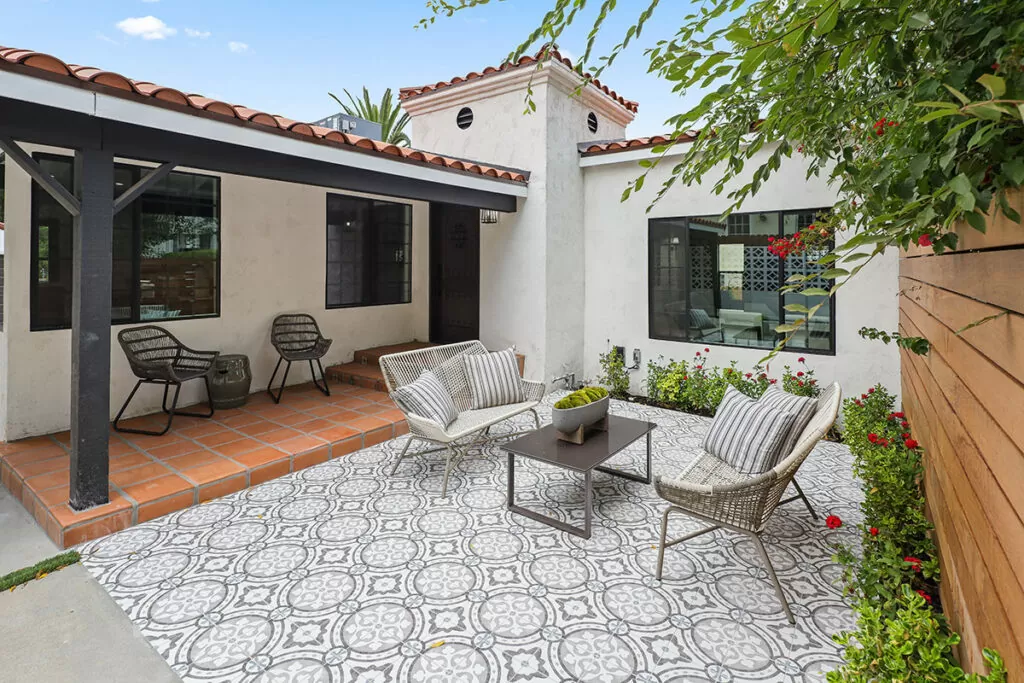
You might not know it, but the history of Spanish patio design is a fascinating journey deeply rooted in the influences of Islamic, Persian and Moorish gardens. The unique architecture of these cultures found its way into the courtyards and terraces of traditional Spanish-style homes, creating an outdoor space that was both functional and aesthetically pleasing. This design concept was born out of necessity due to Spain’s hot, dry climate – encouraging a lifestyle that embraced the outdoors.
As you delve deeper into this historical narrative, you’ll discover how Spanish patios have evolved from ancient times to play a pivotal role in modern landscape architecture. You see, the Spanish understood early on how to create distinct rooms within their garden layout using walls and partitioning techniques. These walled sections gave birth to intimate patio areas where families could gather for meals or relax during siestas. Fountains were added as central features for their soothing sounds and cooling effects, while Moorish lanterns provided subtle illumination after sunset.
The beauty of Spanish patio design lies not just in its visual appeal but also in its versatility and adaptability over centuries. These designs are not confined to only grand estates or sprawling villas; they can be incorporated into any size yard or garden with careful planning and attention to detail. By selecting elements such as Saltillo tiles for flooring, carved Cantera forms for decoration, or slump block walls for privacy – you can recreate your very own slice of Spain right at home! The key is consistency in design elements across different parts of your property so everything ties together beautifully without appearing disjointed or forced. So go ahead – let history inspire your next outdoor project!

Characteristics A of Spanish Patio Design
Incorporating the charm of a traditional Iberian courtyard, elements such as decorative tiles, vibrant flowers, and rustic furniture play pivotal roles in crafting this unique outdoor aesthetic. The characteristics of Spanish patio design lend themselves to a warm, inviting atmosphere that is both functional and beautiful. At its core, it’s all about creating an extension of your home that embraces the Mediterranean style. This design often includes stucco walls painted in earthy hues or white for a fresh look. Terracotta rooftops are another iconic feature adding authenticity to your outdoor patios.
A key characteristic you’ll notice in Spanish patio designs is the use of Spanish tiles. These intricate tiles boast rich colors and detailed patterns – they’re not only visually stunning but are also known for their durability and versatility. You can use them on the floor to create eye-catching walkways or on the walls to introduce color and texture into your space.
Other hallmarks include lush greenery, from potted plants to sprawling vines that add a touch of nature while enhancing privacy in outdoor living spaces. Water features like fountains are also quite common; they offer tranquility while serving as focal points within these external sanctuaries. Outdoor furniture tends to be robust and substantial – think wrought iron tables or rustic wooden benches – providing comfortable seating without sacrificing style or durability. Remember, the goal of any Spanish patio design is not just function but also beauty; it’s about crafting an enchanting retreat where you can enjoy life’s simple pleasures amidst striking aesthetics inspired by Spain’s rich cultural heritage.
Materials Used in Spanish Patio Design
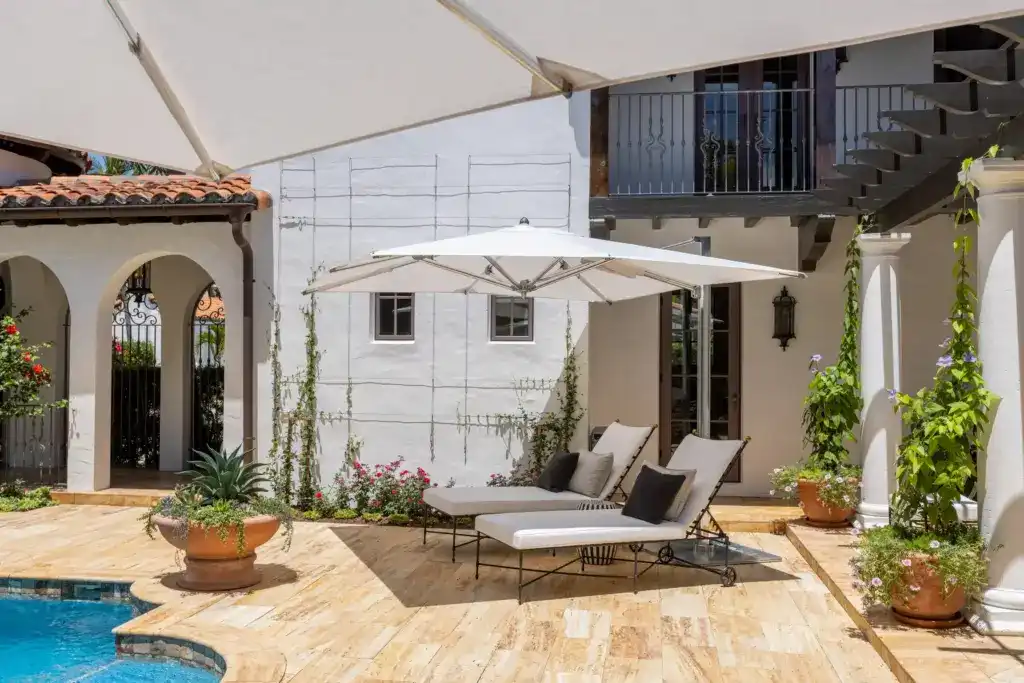
When it comes to crafting an authentic Mediterranean vibe, the materials used play a crucial role. Spanish patio design focuses on using natural materials and earthy textures to create a welcoming outdoor space that feels both rustic and refined. Consider using stucco for walls or fences; its rough texture provides a striking contrast with the sleek lines of contemporary exterior designs while maintaining an old-world charm. For your floors, why not opt for a stone patio? The varying hues of natural stones will add depth and visual interest to your space.
Next, let’s talk about tiles – an indispensable part of any Spanish patio design. Traditionally, terracotta tiles are used in these spaces due to their warm tones, which complement the overall aesthetic perfectly. But don’t be afraid to experiment! You can also use colorful ceramic tiles with intricate patterns for a more vibrant look. Remember, Spanish patios are all about celebrating colors and boldness, so feel free to incorporate dynamic patterns through your tile choices.
Now onto greenery – although not technically a ‘material,’ vegetation is vital in creating that lush Spanish ambiance we’re after. Don’t shy away from incorporating hanging baskets overflowing with geraniums or terracotta urns trailing ivy; they’ll surely bring life into your space while adding another layer of texture and color. To elevate the sense of privacy and romance in your patio area, consider climbing vines like Bougainvillea up trellises or wrought iron fences – you’ll love how they frame your outdoor haven beautifully! Whether it’s stone patios, vibrant tiles, or lush greenery, each element contributes to making your Spanish-inspired patio ooze character and warmth!
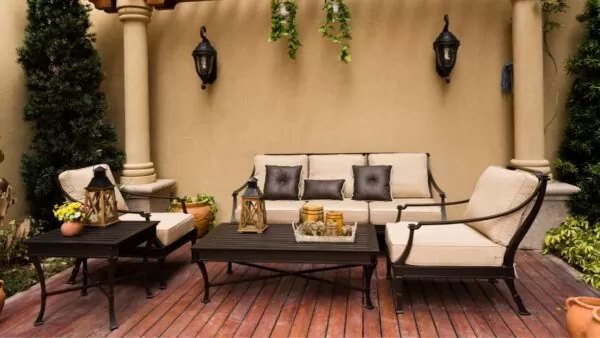
Popular Spanish Patio Design Elements
Imagine stepping into your own personal oasis, adorned with vibrant tiles, lush greenery and the soothing sound of an ornate fountain; these are just a few elements that can transport you straight to the heart of Mediterranean living. This is the essence of Spanish patio design – a style that blends functionality with aesthetic appeal to create an inviting outdoor space. With its roots in Spain’s rich architectural history, this design style has evolved over centuries to suit modern lifestyles but still retains key features that make it unmistakably Spanish.
One popular Spanish patio design element is the courtyard, traditionally seen in hacienda-style homes. These exterior courtyards serve as open-air living rooms where families gather for meals, relaxation, or socializing. They are typically surrounded by white stucco walls and feature charming details like carved wooden doors and arches, terracotta tiled roofs and wrought iron grilles – all hallmarks of Mediterranean architecture. Another crucial element is the use of colorful decorative tiles, which add a dash of vibrancy while maintaining a rustic charm.
You’ll also find heavy wooden patio tables for alfresco dining and chunky stone work adding texture and depth to these spaces. Plant life plays a significant role, too; expect to see hanging baskets filled with flowers or even vines climbing up walls adding another layer of visual interest. The incorporation of water elements like fountains isn’t merely decorative; they contribute towards creating a serene atmosphere through their calming sounds. So whether you’re sipping on freshly brewed coffee under the shade provided by tall ceilings or admiring intricate tile mosaics underfoot, every aspect contributes towards making your patio feel more like an extension of your home rather than just an outdoor area.
Examples of Spanish Patio Design

You’ll be absolutely amazed by how a touch of Mediterranean magic can transform your outdoor space into an atmospheric retreat. Spanish patio design is known for its elegance and warmth, bringing together the rustic charm of Spain with modern comfort. With the right elements, you can recreate this ambiance in your own backyard. Whether you have a sprawling lawn or a small balcony, there are plenty of examples of Spanish patio design that can inspire you to revamp your outdoor space.
To bring some Spanish flair into your home, consider these striking patio design ideas:
- Tile Mosaics: Use these for a unique and colorful design element.
- Carved Wooden Doors: Use these as entrances to your patio or outdoor kitchen.
- Ornate Ironwork: Incorporate ornate ironwork in elements like gates, railings, or decorative pieces.
- Verandas: A covered veranda can provide shade and a comfortable space to relax.
- Vines Climbing Up a Wall: Plant climbing vines to add a touch of nature and soften the look of walls.
- Large, Curved Windows: If your patio is adjacent to your home, consider incorporating large, curved windows for a seamless indoor-outdoor connection.
- Exterior Courtyards: Design an open courtyard with a fire pit or seating area for outdoor gatherings.
- Colorful Decorative Tiles: Use these to add a pop of color and pattern to your patio floor or as accents in your outdoor kitchen or fireplace.
- Wrought Iron Chandeliers: These can add a touch of elegance to your outdoor dining or seating area.
- Wooden Shutters: Use these to provide shade and privacy.
- Arches: Incorporate arches in your patio design for a classic Spanish touch.
- Ornate Fireplaces: An outdoor fireplace can be both functional and a beautiful focal point.
- Natural Materials: Use materials like wood and stone to create a rustic and natural feel.
- Multiple Levels: Design your patio on different levels to add depth and interest to the space.
- Murals: Consider a mural on an exterior wall to add a unique artistic element.
- Tile Floors: Use colorful tiles to create a vibrant and durable patio floor.
- Fountains: A water feature can add a soothing element to your outdoor space.
- Terracotta Tiled Roofs: Consider a pergola or gazebo with a terracotta tiled roof for a touch of Spanish charm.
- Hanging Baskets: Use these for adding color and life to flowers or trailing plants.
- Arched Doorways: Incorporate these into your design for a classic Spanish touch.

As you explore these examples of Spanish patio design remember it’s all about creating an inviting environment where you can relax or entertain friends and family – much like what patios represent in Spain itself! Implementing these few key elements will help elevate any outdoor patio into something that feels special and unique while still offering functionality for everyday use.
You don’t need to worry if you’re working with limited space; even compact areas can be transformed into stunning retreats with thoughtful planning and attention to detail. Incorporate plants native to Spain, such as olive trees or lavender, for authentic flora representation; colorful cushions on wrought iron furniture add comfort while keeping within the style’s aesthetic; and decorative accessories like lanterns or ceramics contribute towards achieving that sought-after rustic charm associated with Spanish culture. So go ahead, let these inspiring designs guide your way toward crafting an enchanting escape right at home!

Benefits of Spanish Patio Design
Embracing this Mediterranean-inspired theme for your outdoor space offers more than just aesthetic appeal; it’s a lifestyle choice that promotes relaxation, socializing, and enjoyment of nature. The benefits of Spanish patio design go beyond the visual; they create an atmosphere where you can unwind from your daily stresses and enjoy quality time with friends and family. This style is characterized by a blend of indoor and outdoor living spaces, creating seamless transitions between the two. Imagine stepping out onto your patio garden on a warm evening, the outdoor lighting softly illuminating the space as you relax amidst lush greenery.
The second major advantage of Spanish patio design lies in its ability to maximize space utilization. Whether your backyard is sprawling or compact, this approach makes clever use of every inch available. With careful planning and attention to detail, areas traditionally used for storage or left undeveloped are transformed into charming alcoves perfect for dining or lounging. Furthermore, Spanish patios often incorporate water features like fountains or small ponds that not only add an extra level of tranquility but also serve as focal points that enhance the overall design.
A third benefit is how Spanish patio designs encourage interaction with nature. By integrating plants native to the Mediterranean region—olive trees, lavender bushes, rosemary—you bring a piece of that world right into your backyard while promoting biodiversity in your local ecosystem. Plus, these choices are typically drought-tolerant and require less maintenance than other garden varieties—a win-win! So if you’re considering a new look for your outdoor area—or dreaming up plans for one—the practical advantages and serene ambiance offered by Spanish patio designs make them an option worth exploring.
How Does Spanish Style Compare to Mediterranean Style?
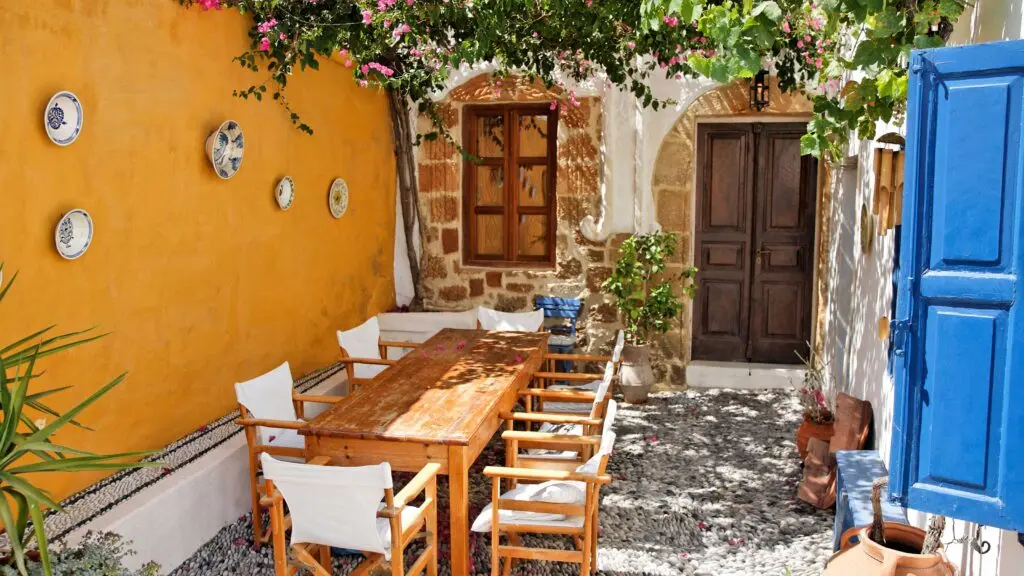
While they’re often grouped together due to their shared emphasis on natural materials and indoor-outdoor living, there’s a distinct difference between the aesthetics of Mediterranean and Spanish styles. Most notably, when it comes to your patio design, you’ll find that Spanish-style homes tend to utilize more rounded features. This can extend beyond just windows and archways to include elements such as walls or even the layout of your outdoor space itself. On the other hand, Mediterranean-style homes lean heavily towards symmetry and simplicity while still maintaining an elegant appeal.
Diving deeper into the interior design aspects, you can observe that the Mediterranean style is influenced by a variety of countries surrounding the Mediterranean Sea, including France, Italy, and Greece, among others. Often considered a subset of broader coastal interior design trends, this look embodies airy interiors with rich moments of color and eclectic tile work – perfect for those looking to add some character to their patio. In contrast, Spanish interior design showcases characteristics like large curved windows, ornate ironwork – often used in stair railings or balconies; wall paintings – usually depicting religious scenes; colorful decorative tiles; fountains; carved wooden doors, which all contribute to creating an atmosphere reminiscent of traditional Spanish culture.
When planning your Spanish patio design, consider using natural materials like wood or stone combined with decorative tiles to create a unique outdoor space that truly represents the essence of Spain. You could also consider incorporating elements such as murals or stained glass windows, which are common features in Spanish-style homes. However, it’s important not to overdo these elements as they could potentially overpower your space; instead, aim for balance within your designs. As opposed to this, if you’re leaning towards a Mediterranean style, ensure you maintain symmetry within your designs while making use of simple colors paired with pops of bright hues for that classic Mediterranean appeal!

Is the Spanish Patio Style Considered Modern or Vintage
In the realm of interior décor, it’s clear that the charm and allure of a Spanish-style outdoor haven can be considered both modern and vintage. The Spanish patio design seamlessly marries old-world elements with contemporary aesthetics to create a timeless appeal. This style is not confined to the boundaries of being either completely modern or purely vintage; instead, it draws from the best attributes of both eras resulting in a unique blend that adds character and warmth to your patio.
- Wrought iron or aluminum patio furniture brings a touch of old-world Spain, while also adding a touch of sophistication to any era.
- Vibrant colors mixed with neutral tones offer a balanced palette that fits perfectly into today’s design trends while paying homage to traditional Spanish aesthetics.
- Ceramic tiles with intricate designs are commonly found in Spanish patios, which provide historic charm but serve as an interesting focal point even in contemporary settings.
Whether you’re aiming for a sleek, minimalistic look or wanting to recreate the rustic charm reminiscent of Andalusian courtyards, you’ll find that incorporating elements from the Spanish patio design will serve your purpose. Remember, this style is all about creating harmony between different components – use vibrant colors sparingly against a backdrop of neutral tones; balance out wrought iron pieces with softer textures like cushions or rugs. The key here is achieving equilibrium between contrasting elements so no single aspect overpowers another. The result? A stunning outdoor space brimming with personality – one where every element tells its own story while contributing to a cohesive whole.
While choosing this design style may seem daunting at first due to its dual nature – blending modern sensibilities with vintage charms – once you start embracing its principles, you’ll discover how versatile and fascinating it truly is. You don’t have to go full-on flamenco dancer or bullfighter-inspired when styling your patio (unless you want to!). Instead, let each choice reflect your taste while still maintaining those distinctively Spanish touches – from archways and tiled floors right down to potted plants brimming with bright blooms. With thoughtful planning and selection, your patio could soon become that delightful fusion of modern functionality enveloped by alluring hints of vintage Spain!
Tips for Incorporating Spanish Patio Design
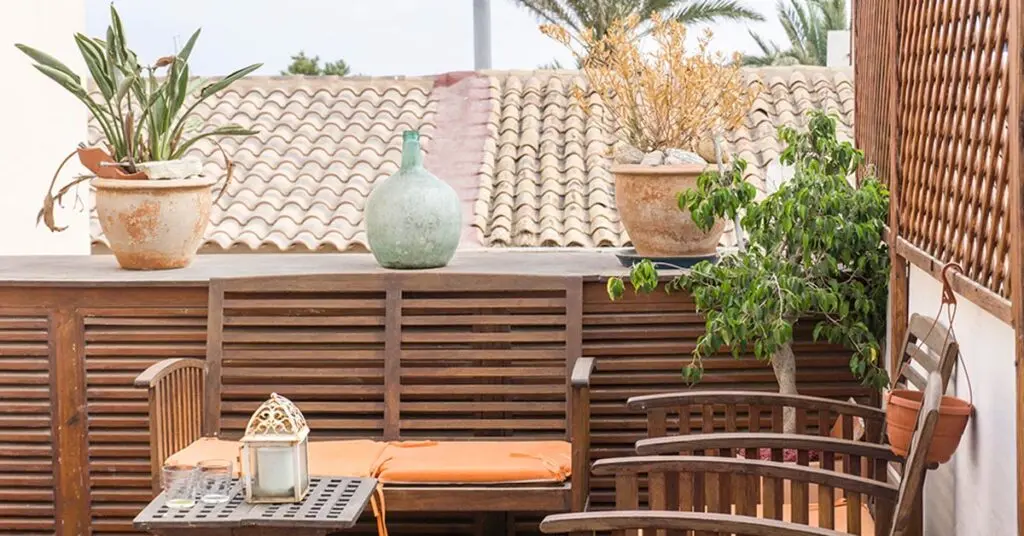
Looking for ways to add that authentic Mediterranean vibe to your outdoor living space? We’ve got some handy tips up our sleeves. Spanish patio design is all about creating a warm, inviting atmosphere where you can enjoy the outdoors in style. It’s not just about backyard landscaping; it’s about incorporating elements of Spanish culture and architecture into your outdoor decor.
Firstly, consider using terracotta tiles or cobblestone for your patio floor. They’re a staple in Spanish design and will instantly give your area an old-world feel. For furniture, opt for rustic wood pieces that mirror the dark wooden doors common in Spanish homes. Wrought iron accents also provide a classic touch, whether they’re part of the furniture itself or used as decorative elements like wall hangings or lanterns.
Lastly, don’t forget about color! Vibrant hues are a hallmark of Spanish design- think warm reds, yellows and oranges paired with cool blues and greens. Use these colors liberally throughout your patio for an authentic look and feel. And remember, no Spanish patio would be complete without plenty of plants – from lush greenery to flowering vines climbing up walls or trellises. So there you have it – by following these tips and incorporating these key elements into your outdoor space, you’ll be well on your way to creating an enchanting Spanish-style patio that’s perfect for entertaining or simply enjoying a quiet evening under the stars.
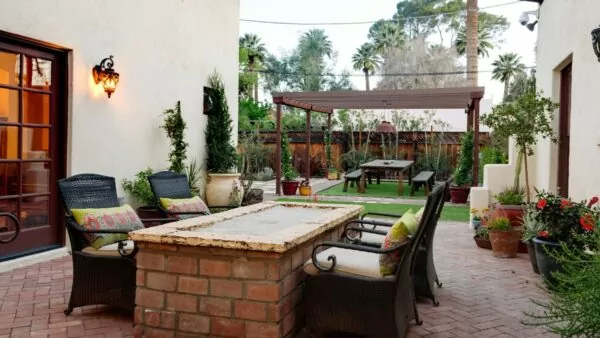
Conclusion
In the end, you see, Spanish patio design is a timeless blend of history, culture, and aesthetics. It’s not just about style; it’s also a celebration of outdoor living, embracing warmth, comfort and sociability.
Whether you’re after a vintage feel or craving modern sophistication, remember that your Spanish patio can be whatever you want it to be. Go ahead and experiment with elements that sing to your soul. After all, it’s all about creating a space that truly feels like home!
At PatioProductions.com, we are dedicated to assisting customers in crafting their ideal Spanish patio design. With our expertise and extensive range of options, we strive to help you create a space that truly feels like home.

Todd is a co-owner of Patio Productions and has worked extensively in the furniture industry since 2002, when he started a company that designed and manufactured bathroom vanities. He now has a hand in all online business operations, including keeping tabs on industry trends and making sure Patio Productions remains an innovative leader in the outdoor furniture space. He lives just outside of Denver, Colorado with his wife, two boys, and two dogs. They live on a lake where they can make the most of the outdoor lifestyle. His favorite patio furniture sets are his Harmonia Living sectionals.

